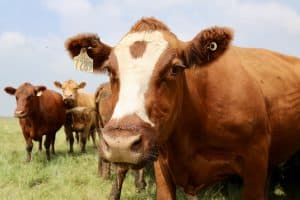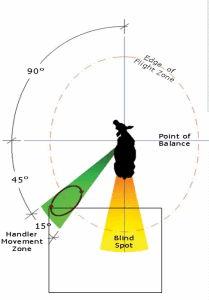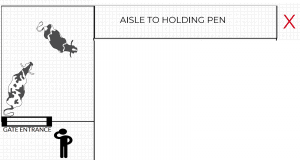 Working with large animals can be challenging for farmers and workers…
Working with large animals can be challenging for farmers and workers…
UMASH has developed training guides to accompany the 5-part video series on Dairy Stockmanship.
These guides are intended for training by farmers, ranchers, farm employees, veterinarians, human resources training staff and those involved with worker health and safety training/education.
The guides can be a tool for training and retraining workers. The materials can be used in small groups or individually. There is a short quiz at the end of each video to check your understanding. After completing the five videos and related quizzes, a certificate of completion is available for printing.
Using Predictable Animal Behavior to Increase Milk Production
Learning Objectives
- Identify factors that impact livestock well-being.
- Define stockmanship.
- Understand how cattle behavior impacts the way handlers work with them.
- Understand the benefits of good cattle handling practices.
- What is stockmanship?
- Why is stockmanship important?
- List reasons why it’s important to have good stockmanship handling practices. What are some examples of “good” practices.
- Discuss how evolution makes a cow’s behavior predictable and how that helps to understand the best cattle handling practices.
- Discuss factors that impact livestock well-being. What experiences do you have or know of that you can share?
Each person completing the training should take the quiz.
Online QuizContinue to: Part 2: How a Cow Uses Her Senses
For additional practice, use the following:
- Watch (7:00 minutes) Stockmanship – Working Cattle Through Your Facility – A video to help with cattle handling.
- Watch (27:06 minutes) Dairy Stockmanship – A training video to help with handling and safety of stockmanship. It includes interactive questions to use while watching the video.
- Read: On Pasture: Translating research and experience into practices you can use NOW! to get recent news, tips and stories about stockmanship.
- Search Stockmanship in YouTube for just in time training and stories to help you with stockmanship practices.
How a Cow Uses Her Senses
Learning Objectives
- Identify the importance of a cow’s senses.
- What to do and what not to do when working with cows, given their acute senses.
- What handler behaviors or circumstances might startle a cow and how does a stressed cow affect other cattle?
- What farmers can do to positively use touch when promoting a cow’s well-being?
- What are the most acute senses of a cow? Discuss each sense (sight, sound, smell, touch) and how you would recommend working with a cow knowing how they act/react to each sense.
- How can you positively use touch to promote an animal’s well-being? What should you avoid using/doing to move cattle? What should you do in order to keep interactions positive?
- Other warning signs that a cow is distressed or threatened can include frequent urination, rapid heart rate, trembling, open-mouthed breathing and slobbering. Discuss how to both notice these signs and how to alleviate threats to avoid distressing a cow.
Each person completing the training should take the quiz.
Online QuizContinue to Part 3: Working With the Pressure Zone
For additional practice, use the following:
- Watch (3:52 minutes) Using the Senses in Handling Cattle – A video to help learn a cattle’s senses and best practices for handling them accordingly; Includes interactive questions to test your knowledge.
- Watch (1:26 minutes ) Cow Senses – This (audio-free) presentation shows how cows experience the world through their senses and how to handle them effectively.
- Read Cattle Senses (1-page) – An article that summarizes cow’s senses and ideas for helping cows feel at ease.
- Read Cattle Behavior (30 pages) – This chapter discusses the details of cattle behaviour (in other words, what cattle do) such as the relative importance of the five body senses, the various ways stock communicate with each other and their keepers and behavioural problems arising from clashes with their environment.
- Read We Must Communicate to Cattle’s Senses in Hoards Dairyman (1-page) – An article that describes how cows interpret their environment using the five senses and what handlers do to stimulate these senses.
Working with the Pressure Zone
Learning Objectives
- Understand and define the pressure zone and flight zone on cattle.
- Identify the edges of a cow’s flight and pressure zones.
- Describe how the environment affects a cow’s pressure zone and what this means for handlers.
- Understand unique pressure and flight zones of individual cows and the best way to move herds.
- Explain ways to apply low stress methods and the importance of using pressure zone methods when handling cows.
- Recall how to identify where the edge of the flight zone is. Discuss your own cattle methods when working with cattle’s flight zones.
- How do factors in the environment affect the pressure zone of a cow and how can a handler use these to their advantage when guiding the cow?
Refer to Figure 1:
- If you were standing in the “handler movement zone” and wanted to move this cow in the opposite direction, where would you move and why?

Figure 1
Continue to Part 4: Moving Cows More Effectively
For additional practice, use the following:
- Watch (6:14 minutes) Low Stress Cattle Handling – A video to discuss methods to effectively move cattle with the minimal amount of stress to the animal as well as the handler.
- Watch (1:57 minutes) Using Pressure and Release When Moving Dairy Cattle – A training video to teach where to use pressure when moving cattle.
- Watch (4:07minutes ) Understanding Flight Zone – A video to teach how to use the flight zone when handling cattle.
- Read How to approach cattle (1-page) An article that discusses approaching cattle properly so you’re not a threat; Remembering that cattle can’t handle the emotional part of something coming directly at them to start them.
Moving Cows More Effectively
Learning Objectives
- Understand how the cow’s head and nose position relates to their movement.
- Discuss ways to move a cow (location, speed, blindspot, pressure zone, etc.).
- Demonstrate the zig-zag method for moving cows.
- When approaching a cow, discuss all factors to keep in mind to move her effectively.
- Describe the zig-zag method and how it works to move cows effectively. Demonstrate how this method works within your group.
Refer to Figure 1:
- Move the two cows into the holding pen (Marked with an X). Describe your movements while approaching the gate and how you will move the cows. Draw your movement in the pen upon entrance of the gate until the cows are at X.

Figure 1
Continue to Part 5: Making the Milking Parlor a Happy Place
For additional practice, use the following:
- Watch (1:15 minutes) Adjusting the speed of cattle by moving along side the herd – A video to show how to slow and speed up cattle in herd.
- Watch (10:39 minutes) Moving Cattle on Foot – In the field, this video shows techniques for moving cattle using their reactions, movement, flight zone, low-stress handling methods, balance point, etc. to control herd movement.
- Read Start Herd Movement the Right Way (1-page) – An article that introduces effective tips and checklists for moving cattle in a herd.
- Watch (18:35 minutes) Using Natural Cattle Behavior to Move Cattle – A training video (low quality audio but highly informative) to teach how to approach a cow and use the cattle’s behavior to move a cow and a herd.
Quiz 4 Answer Key
Making the Milking Parlor a Happy Place
Learning Objectives
- Understand the importance of calm cows prior to milking.
- Understand the connection between stressed cows and impaired milk production.
- Explain proper techniques for crowd gate and cow movement when moving cattle into the milk parlor.
- Discuss stockmanship practices learned throughout the 5-part stockmanship series to help cattle to have calm milking parlor experiences.
- Research shows that it can take up to 40 minutes for a stressed cow to completely settle to a relaxed state. Exchange views on the impairments of a cow and milk production when a cow is stressed.
- When moving cows to the milking parlor, what are the top things that should be considered to make it a positive interaction? Exchange best practices you can use to create happy cows in the milking parlor.
- If cows are not entering the milking parlor from the holding pen, what are some ways you would help them move into the area?
- When a heifer enters a parlor for the first time, what actions and circumstances should be considered in order to establish a positive association with the parlor?
Continue to the final quiz
Take the Final Quiz
Once you have reviewed all videos and completed each quiz, please take the Final Quiz and receive a Certificate of Completion. Good luck and thank you for participating in this program!
Online QuizAfter completing the Final Quiz, download and print a Certificate of Completion to be signed by your supervisor (the participant can fill his/her name into the fillable form) to document completion of the training if needed.
Printable CetrificateFor additional practice, use the following:
- Watch (6:08 minutes) Handling Cattle in Alleys, Holding Areas and Milking Parlors – This training video teachers a handler how to effectively more cattle.
- Read Three ways to improve dairy handling for low stress and high production (1-page) – An article for dairy farmers and handlers that discusses factors to consider as guidelines of humane handling to help livestock optimize production.
- Watch (2:38 minutes) Milking Process and Handling Facilities – This audio-free video discusses best practices for the milking process.
- Watch (5-minutes) Happy Cow Milk Process – A video that walks through the milking process at Happy Cow
- Watch (34:57 minutes) The Importance of Good Stockmanship by Temple Grandin – A recorded lecture by Temple Granin to discuss the importance of using good stockmanship techniques.
UMASH offers additional resources on Positive Animal Handling including barn posters and fact sheets in English and Spanish.
- Visit our Animal Handling Page to learn more.
